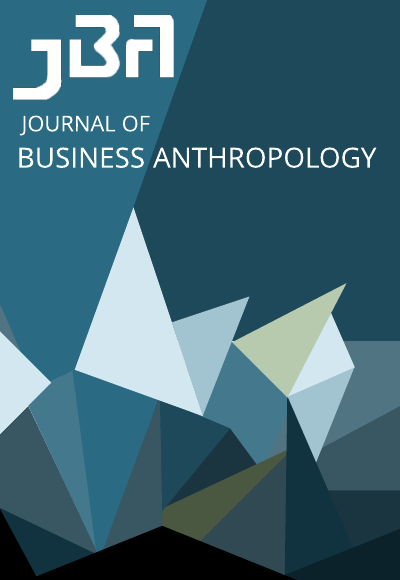Contested Spaces, Shared Concerns
Road Interactions from the Perspective of Three User Groups
DOI:
https://doi.org/10.22439/jba.v9i2.6118Abstract
Roadways are sociocultural spaces constructed for human travel which embody intersections of technology, transportation, and culture. In order to navigate these spaces successfully, autonomous vehicles must be able to respond to the needs and practices of those who use the road. We conducted research on how cyclists, solid waste truck drivers, and crossing guards experience the driving behaviors of other road users, to inform the development of autonomous vehicles. We found that the roadways were contested spaces, with each road user group enacting their own social constructions of the road. Furthermore, the three groups we worked with all felt marginalized by comparison with car drivers, who were ideologically and often physically dominant on the road. This article is based on research for the Nissan Research Center - Silicon Valley, which took place as part of a Design Anthropology course at the University of North Texas.
References
Bourdieu, Pierre, trans. Richard Nice. 1977. Outline of a theory of practice. Cambridge: Cambridge University Press. https://doi.org/10.1017/CBO9780511812507
Crute, Jeremy, William Riggs, Timothy S. Chapin, and Lindsay Stevens. 2019. Planning for autonomous mobility: PAS Report 592. Chicago: American Planning Association.
De Certeau, Michel, trans. Steven Rendall. 1984. The practices of everyday life. Berkeley: University of California Press.
Friedel, Robert. 2007. A culture of improvement: Technology and the western millennium. Cambridge: MIT Press.
Haddington, Pentti and Mirka Rauniomaa. 2014. “Interaction between road users: Offering space in traffic.” Space and Culture 17(2):176-190. https://doi.org/10.1177/1206331213508498
Hitchcock, Louise A. 2008. “Henri Lefebvre.” In Theory for classics: A student’s guide, 180-184. London: Routledge. https://doi.org/10.4324/9780203932919
Ingold, Tim. 2000. “Chapter 13: To journey along a way of life: Maps, wayfinding and navigation.” In The perception of the environment: Essays on livelihood, dwelling and skill, 219-242. London: Routledge.
Kunstler, James Howard. 1993. The geography of nowhere: The rise and decline of America's man-made landscape. New York: Simon & Schuster.
Kuper, Hilda. 1972. “The language of sites in the politics of space.” American Anthropologist 74 (3): 411-25. https://doi.org/10.1525/aa.1972.74.3.02a00130
Lefebvre, Henri, trans. Donald Nicholson-Smith. 1991. The production of space. Oxford: Blackwell.
Low, Setha M. 2000. On the plaza: The politics of public space and culture. Austin: University of Texas Press.
Low, Setha M. 2009. “Towards an anthropological theory of space and place.” Semiotica 175 (1/4):21-37. https://doi.org/10.1515/semi.2009.041
Low, Setha M., and Denise Lawrence-Zúñiga. 2003. The anthropology of space and place: Locating culture. Malden, MA: Blackwell Publishing.
Lutz, Catherine, and Anne Lutz Fernandez. 2010. Carjacked: The culture of the automobile and its effect on our lives. New York: Palgrave Macmillan.
McIlvenny, Paul, Mathias Broth, and Pentti Haddington. 2014 “Moving together: Mobile formations in interaction.” Space and Culture 17(2):104-106. https://doi.org/10.1177/1206331213508679
Moore, Donald S. 1998. “Subaltern struggles and the politics of place: Remapping resistance in Zimbabwe's eastern highlands.” Cultural Anthropology 13 (3): 344-81. https://doi.org/10.1525/can.1998.13.3.344
Nagle, Robin. 2013. Picking up: On the streets and behind the trucks with the sanitation workers of New York City. New York: Farrar, Straus and Giroux.
Oatman-Stanford, Hunter. 2014. “Murder machines: Why cars will kill 30,000 Americans this year.” Blog post in Collectors Weekly. Available at https://www.collectorsweekly.com/articles/murder-machines/.
Putnam, Robert D. 2000. Bowling alone: The collapse and revival of American community. New York: Simon & Schuster. https://doi.org/10.1145/358916.361990
Riggs, William, and Michael R. Boswell. 2016. “The Bicyclists’ manifesto for an autonomous vehicle future.” Planetizen, September 23. Available at https://www.planetizen.com/node/88564/bicyclists-manifesto-autonomous-vehicle-future.
Sivak, Michael, and Brandon Schoettle. 2014. “Recent decreases in the proportion of persons with a driver’s license across all age groups.” Traffic Injury Prevention 15: 6-9. https://doi.org/10.1080/15389588.2013.839993
Smart Growth America 2019. “Complete Street policies nationwide.” Accessed September 29, 2019. https://smartgrowthamerica.org/program/national-complete-streets-coalition/publications/policy-development/policy-atlas/
Stayton, Erik, and Melissa Cefkin. 2018. “Designed for care: Systems of care and accountability in the work of mobility.” 2018 Ethnographic Praxis in Industry Conference Proceedings:1-16. https://doi.org/10.1111/1559-8918.2018.01211
Udvarhelyi, Éva Tessza. 2009. “Reclaiming the streets — Redefining democracy: The politics of the Critical Mass bicycle movement in Budapest.” Hungarian Studies (23): 121-145.
https://doi.org/10.1556/HStud.23.2009.1.9
Vivanco, Luis. 2013. Reconsidering the bicycle: An anthropological perspective on a new (old) thing. New York: Routledge. https://doi.org/10.4324/9780203584538
Wasson, Christina. 2000. “Ethnography in the field of design.” Human Organization 59(4):377-388. https://doi.org/10.17730/humo.59.4.h13326628n127516
Wasson, Christina, and Susan Squires. 2012. "Localizing the global in technology design." In Applying anthropology in the global village, edited by Christina Wasson, Mary Odell Butler and Jacqueline Copeland-Carson, 251-284. Walnut Creek: Left Coast Press.
Wray, J. Harry. 2015. Pedal Power: The quiet rise of the bicycle in American public life. London: Routledge. https://doi.org/10.4324/9781315632896
Downloads
Published
Issue
Section
License
Authors who publish with this journal agree to the following terms:
- Authors retain copyright and grant the journal right of first publication with the work simultaneously licensed under a Creative Commons Attribution License that allows others to share the work with an acknowledgement of the work's authorship and initial publication in this journal.
- Authors are able to enter into separate, additional contractual arrangements for the non-exclusive distribution of the journal's published version of the work (e.g., post it to an institutional repository or publish it in a book), with an acknowledgement of its initial publication in this journal.
- Authors are permitted and encouraged to post their work online (e.g., in institutional repositories or on their website) prior to and during the submission process, as it can lead to productive exchanges, as well as earlier and greater citation of published work (See The Effect of Open Access).



